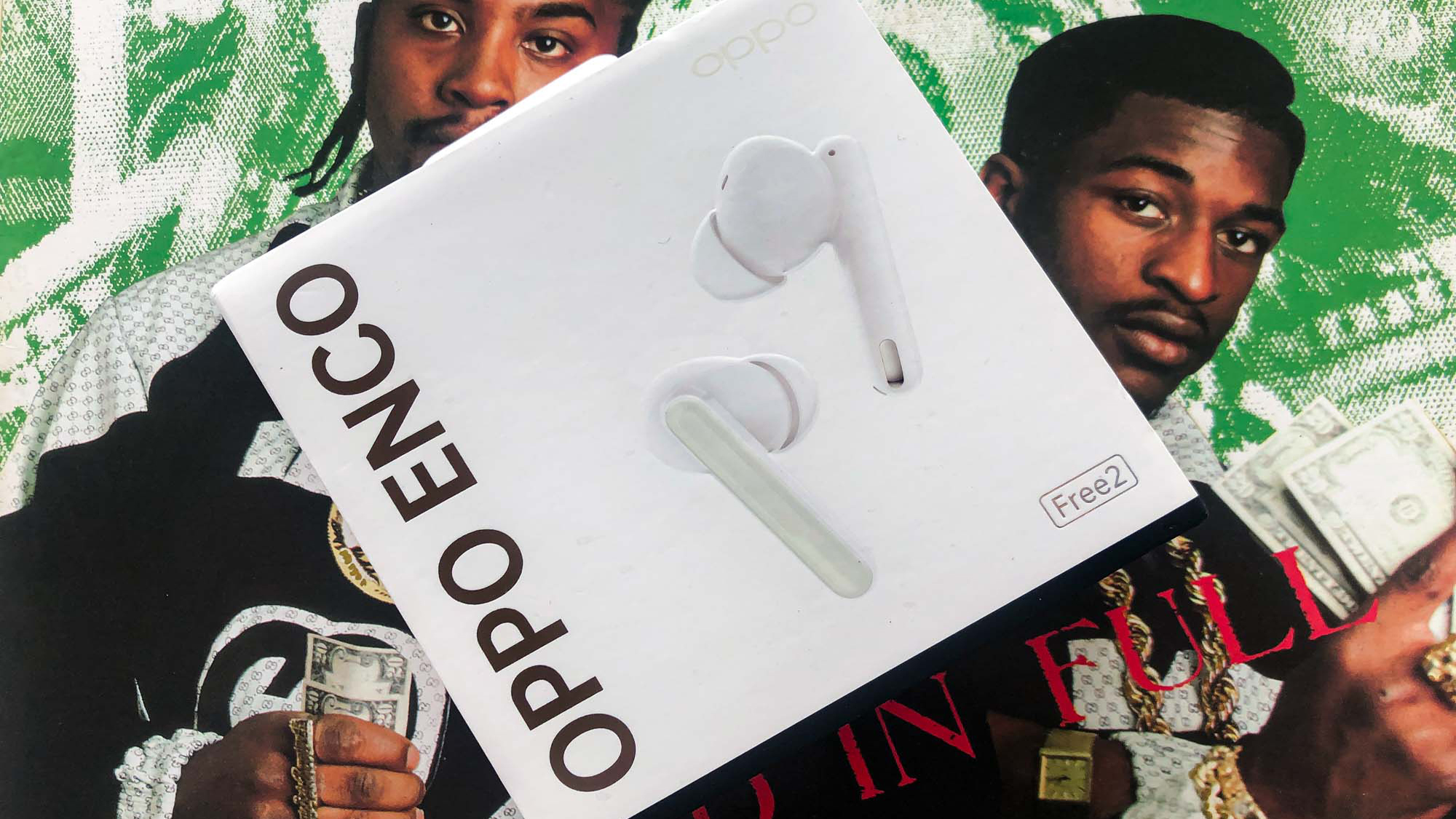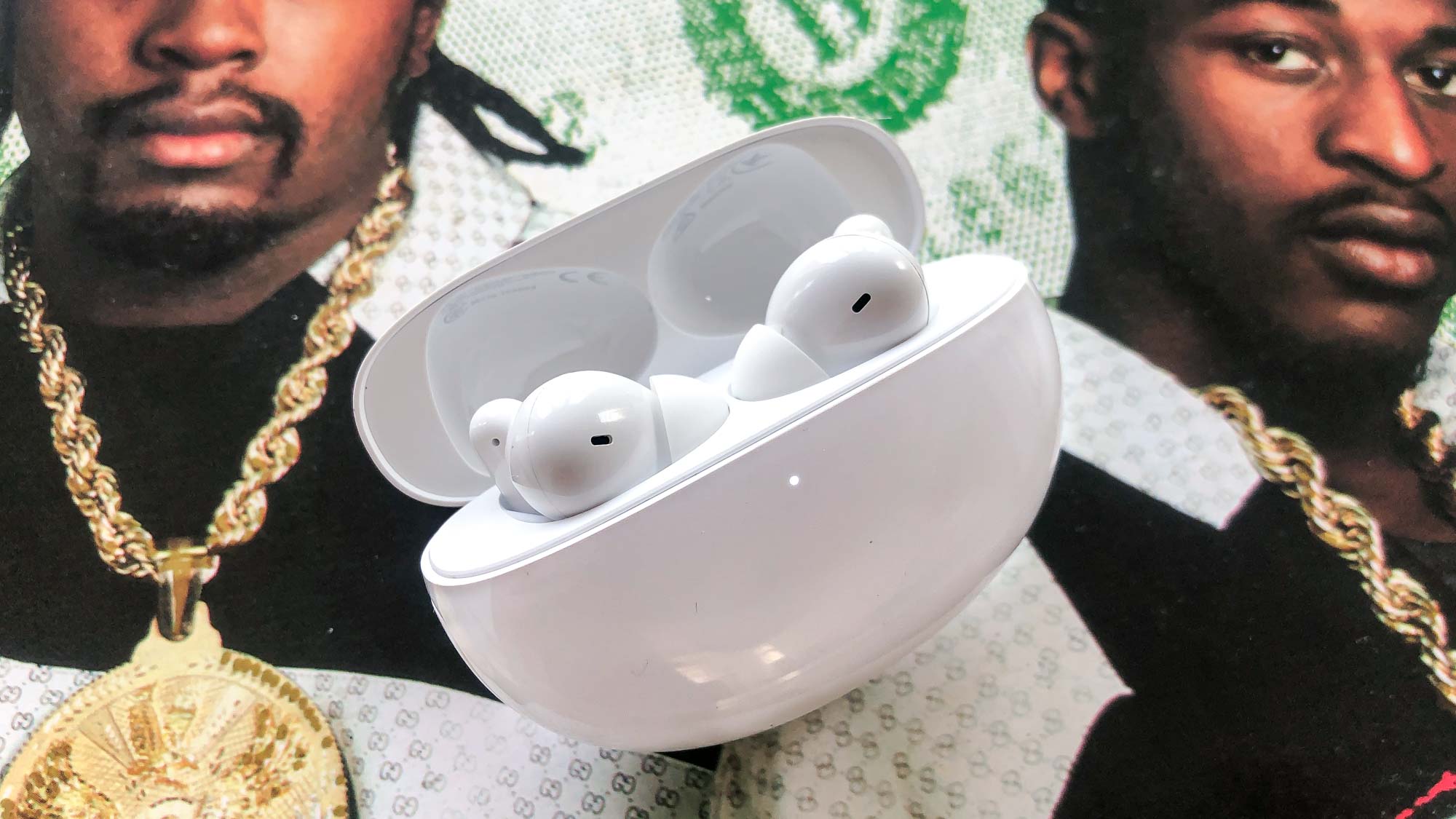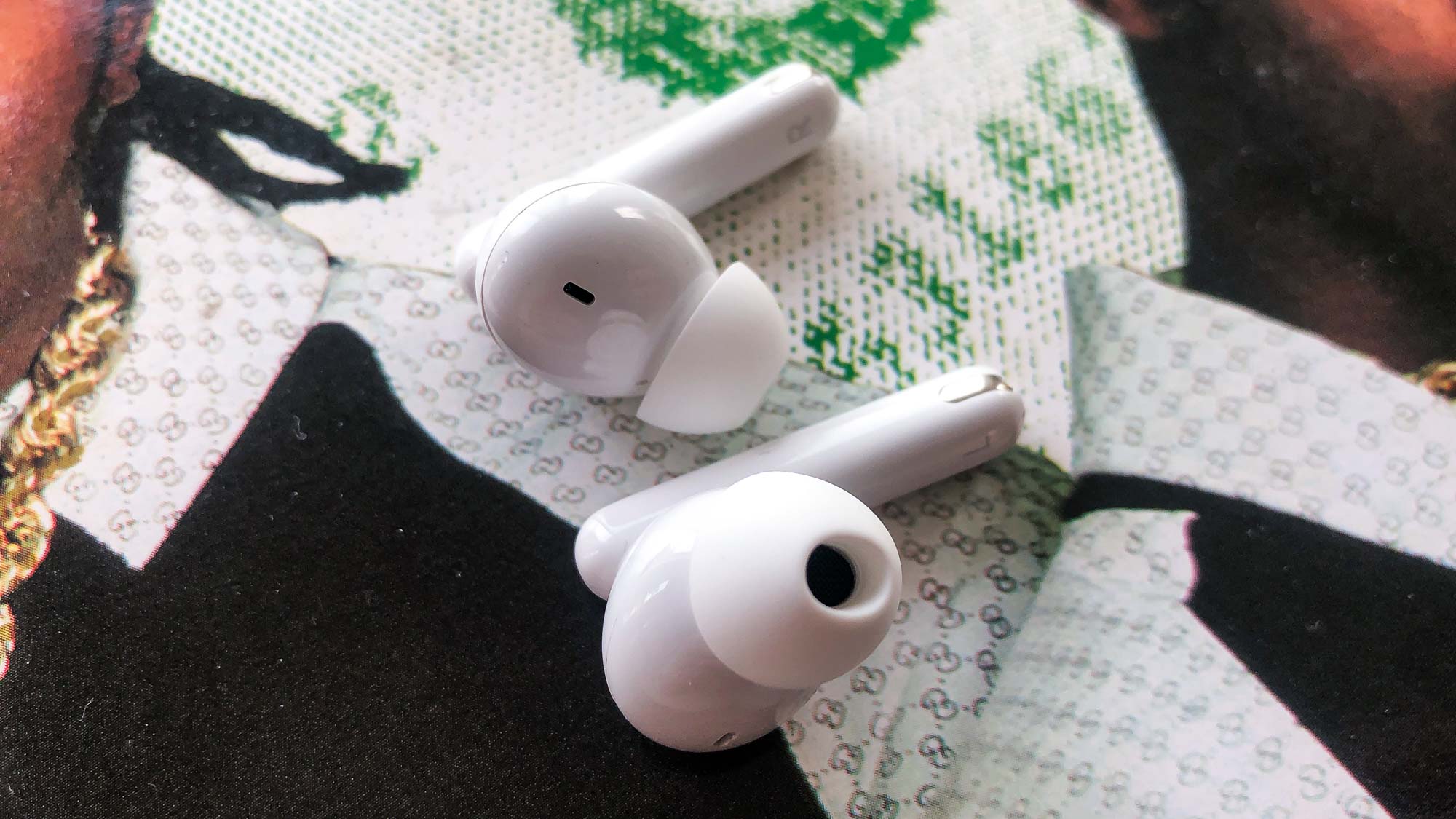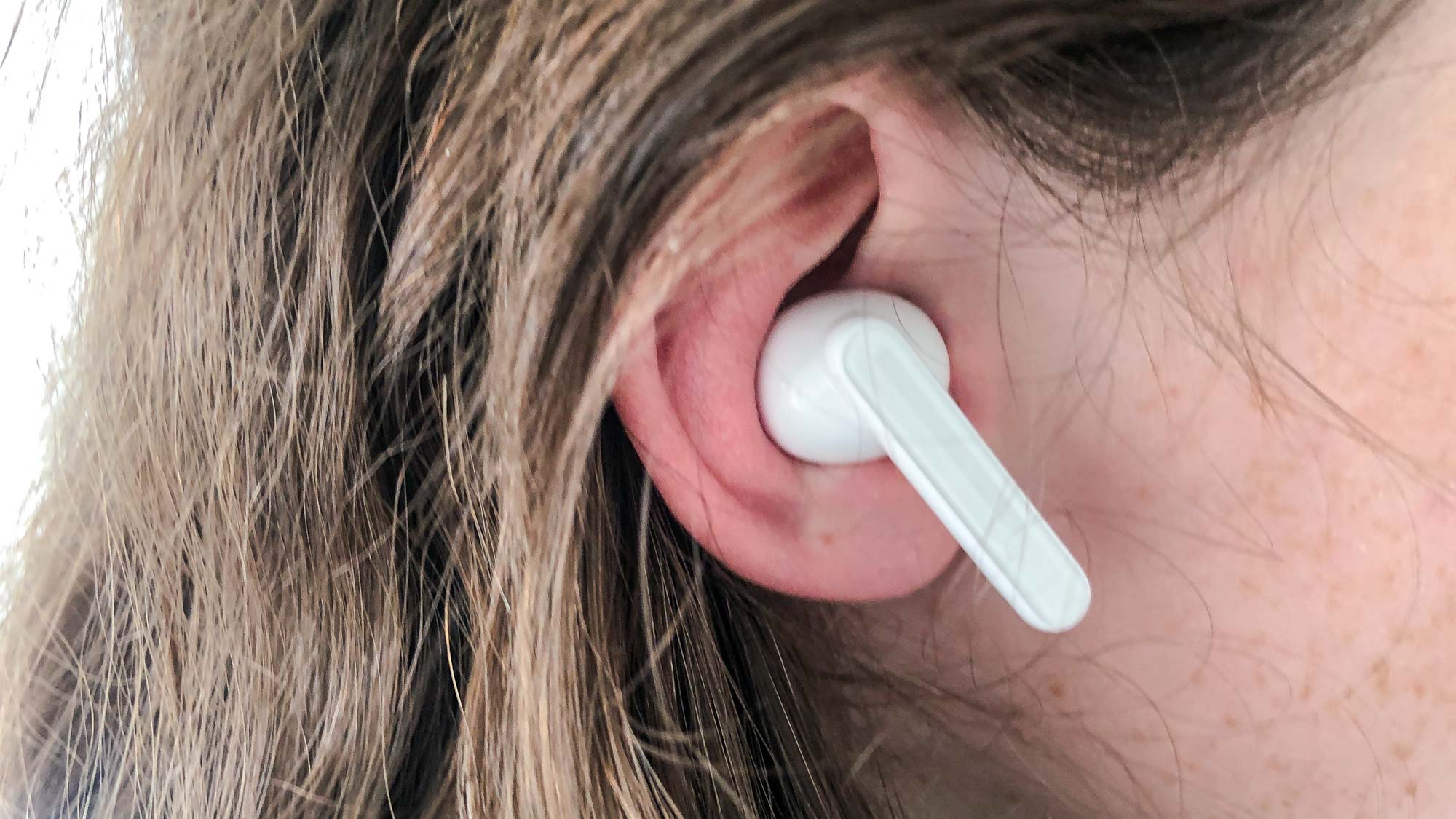Tom's Guide Verdict
The Enco Free2 are an attractive buy for fans of the AirPods-like stem design — but sadly sound quality is not especially high
Pros
- +
Great midrange resolution
- +
Reliable controls
- +
Active noise canceling mode
Cons
- -
Treble can sound edgy at higher volumes
- -
Fit might not be right for all
Why you can trust Tom's Guide
Colors: Black; white
Battery life (rated): Up to 6 hours; 30 hours (charging case)
Connectivity: Bluetooth 5.2 (codecs: SBC, AAC)
Water resistance: Yes (IP54 rated)
Size: Not specified (per bud); Not specified (charging case)
Weight: Not specified (earbuds); 1.67 ounces (charging case)
Oppo, once a formidable high-end home theater player, is a relative newcomer to the burgeoning smartphones market and the Enco Free2 are the second incarnation of its entry-level true wireless earbuds.
The Enco Free2 are certainly specified to compete — after all, active noise-cancellation isn’t all that common in sub-$100 earbuds. Bluetooth 5.2, voice control, dual pairing… these are all equally worthwhile and welcome features. The absolute-best-case 30 hours of battery life is slightly less impressive, though.
And in practice, the Enco Free2 aren’t as alluring as they are in theory. Sound quality is heavily midrange-centric — so while the Oppo do great work with communicating singers, their latent treble spikiness and poorly defined bass reproduction make them a less-than-compelling listen. These sonic shortcomings aren’t helped by the rather vague nature of the way the earbuds fit, either.

Oppo Enco Free2 review: Price and availability
- Active noise cancelling for under $100
- Not currently on sale in the U.S.
The Oppo Enco Free2 are on sale now priced at £89 / AU$199. They're not currently available in the U.S., but U.K. customers can buy them directly through the Oppo UK store as well as online retailers including Amazon, while Australian customers can buy direct through the Oppo Australia store.
You don’t need to be any kind of search-engine genius to establish that while this is a competitive price, there are alternative designs at similar money from rival manufacturers both great and small — check out our best wireless earbuds under $100 and see where the ranked in best fake AirPods roundup. So while some of the niceties of the Enco Free2’s specification help them stand out just a little, they’re going to need to be special if they’re to make a meaningful case for themselves.

Oppo Enco Free2 review: Design
- Drop-stem mimics AirPods' design
- Slightly bulbous enclosure
Faced with the eternal true wireless earbud design choice of ‘small pebble’ or ‘dangly stem’, Oppo has gone with the latter.
The ‘earbud’ part of the design is home to a 3/8inch (10mm) dynamic driver, an oversized design by prevailing standards which goes some way to explaining the rather bulbous nature of the Oppo enclosure. The company is claiming a frequency response of 20Hz to 20kHz, which is ‘full range’ in anyone’s language.
Get instant access to breaking news, the hottest reviews, great deals and helpful tips.

Oppo Enco Free2 review: Comfort and fit
- Imprecise fit
- Rated to IP54 for sweat and water resistance
The earbuds are supplied with ‘S’, ‘M’ and ‘L’ eartips to help secure a decent fit, but those fans of the twist-to-fit ‘small pebble’ alternative design are likely to find these Oppo earbuds give a slightly imprecise fit.
But they’re not all that burdensome in terms of weight, mind you — each earbud tips the scales at just 0.16 ounces. And thanks to an IP54 rating against water and dust, they can confidently be worn in pretty much any real-world conditions.

Oppo Enco Free2 review: Controls
- Reliable touch controls
- Personalized sound
Each earbud has a capacitive touch-surface integrated into the ‘stem’ part of the design, and they prove reliable in operation, responsive and disinclined to shift the fit of the earbuds when they’re used.
Their specific responsibilities can be defined in the third-party ‘Hey Melody’ app (for Android and iOS devices), or Oppo smartphone users can take care of business in their phone’s Bluetooth settings. The app also includes ‘noise control mode’, which cycles between ‘noise-canceling on’, ‘noise-canceling off’ and ‘transparency’ — there’s also the opportunity to take a brief hearing test which lets the earbuds personalize both the sort of noise-canceling they apply and an EQ specific to your hearing characteristics.
In addition, the app features four (scarcely different) EQ presets, battery status indication and the ability to pair the Enco Free2 to a couple of devices simultaneously. Here’s also where you can check for firmware updates.
Control is also available via your source player’s native voice-assistant. The Oppo have a triple-mic set-up to deal with voice-assistant interaction, call quality and noise-cancelation — and it’s no trouble to make yourself understood.

Oppo Enco Free2 review: Sound quality
- Excellent midrange clarity brings out vocalists
- Good bass depth but lacks detail
Oppo has teamed with Danish loudspeaker savant Dynaudio when voicing the Enco Free2 headphones. It's not the first time that brands have partnered, but this is perhaps not the most auspicious example of the collaboration. This is not to say the Enco Free2 are without merit, but there are some areas where they’re not quite a match for their price-comparable rivals.
Midrange reproduction, for example, is very agreeable indeed here. A recording that shines a spotlight on a singer (like Kate Bush’s "Somewhere In Between", for example) is handled very sympathetically by the Oppo — thanks to impressive detail-retrieval and attentiveness to nuance, voices enjoy real character and expression. There’s a wholeness to the way the Enco Free2 deal with vocalists, a willingness to explain their attitude and temperament that’s by no means a given in earbuds at this sort of money.

Elsewhere, soundstaging is confident, so every element of a recording is secure in its position and safe from encroachment. Dynamic headroom for the ‘loud/quiet’ bits is more than adequate, and (at least as far as the midrange is concerned) the harmonic dynamics of a recording are handled with assurance too.
Either side of the midrange is rather problematic, though. As far as the lower frequencies go, the Oppo want nothing for depth — the company’s claim of 20Hz extension seems fair enough. But despite the weight and punch, and despite pretty well organized attack and decay that keeps rhythms sounding naturalistic, there’s a lack of expression to bass sounds that puts them quite strongly at odds with the midrange. Everything that happens at the bottom end is — well, ‘monotonal’ is too strong a description, but it’s kind of appropriate at the same time. There’s no nuance, no light and shade to the way the Free2 describe bass — it just thumps.
At the opposite end of the frequency range, the problems are different but no less significant. Treble sounds are absolutely as bright and as hard as they dare to be — and that’s when playing some sympathetic material. Switch to something with a bit of bite and attitude to its top end ("The Seed" by The Roots is a good example) and the Enco Free2 become overconfident. Volume, predictably, exacerbates this trait — so unless you’re a fan of a top end that can make you wince, you’ll need to keep volume at a realistic level.

Oppo Enco Free2 review: Active noise-canceling
Active noise-canceling is a far less qualified success. The Oppo aren’t going to give Bose QuietComfort 45 earbuds (admittedly at twice the money) any sleepless nights, but they do very acceptable work when dealing with external sounds. And they manage to do so without altering their broad sonic characteristics (which is not in this instance an entirely welcome trait, to be fair).

Oppo Enco Free2 review: Battery life
- Up to 36 hours battery life
- USB-C charging
Oppo is claiming battery life of somewhere between 24 hours (with noise-cancelation switched on — four hours playback from the buds themselves with five further charges from the case), and 36 hours (ANC switched off, six hours from the buds and six from the case). These figures are quite strongly in the ‘good’, rather than the ‘great’, category.
Charging is via the USB-C input on the charging case — there’s no facility for wireless charging. From flat, expect to wait 90 minutes or so before the Enco Free2 are fully charged again.
Oppo Enco Free2 review: Call quality and connectivity
The Oppo use Bluetooth 5.2 for wireless connectivity, which is ideal, and are compatible with SBC and AAC codecs, which is emphatically not. Even at this price-point, it’s not unusual to see aptX or LDAC codec support for some genuinely high-resolution listening. Still, connectivity itself proves solid, and the claimed 10m range is certainly achievable.
And call quality is pretty successful, too. The mic array resists wind-noise well, and intelligibility at either end of a conversation is never an issue.
Oppo Enco Free2 review: Verdict
These are curious true wireless earbuds and no mistake. Where they’re good — active noise-cancelation, control options, midrange fidelity — they’re a match for any real-world rival. But the sound they make is fundamentally skewed, with altogether too much top end attack and a lack of low-end variation. Which ultimately means they’re not the contenders they so easily could have been.

Simon is a freelance technology journalist and consultant, with particular emphasis on the audio/video aspects of home entertainment. Before embracing the carefree life of the freelancer, he was editor of What Hi-Fi? – since then, he's written for titles such as Wired, Metro, The Guardian and Stuff, among many others. Given time, Simon likes nothing more than publishing and then quickly deleting tweets about the state of the nation (in general), the state of Aston Villa (in particular) and the state of his partner's cat.

